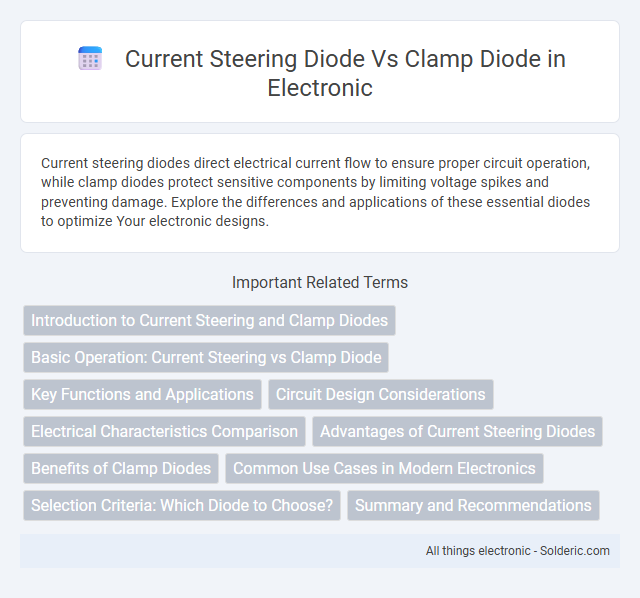Current steering diodes direct electrical current flow to ensure proper circuit operation, while clamp diodes protect sensitive components by limiting voltage spikes and preventing damage. Explore the differences and applications of these essential diodes to optimize Your electronic designs.
Comparison Table
| Feature | Current Steering Diode | Clamp Diode |
|---|---|---|
| Primary Function | Directs current flow in a specific path | Limits voltage by clamping to a safe level |
| Application | Current steering circuits, multiplexers | Overvoltage protection, voltage clamping |
| Voltage Handling | Operates within normal circuit voltage | Activated at voltage exceeding a threshold |
| Current Flow | Steers continuous current flow | Conducts only during transient or excess voltage |
| Impact on Circuit | Controls signal routing without distortion | Protects components by absorbing voltage spikes |
| Typical Devices | BJT, CMOS current steering logic | Zener diode, TVS diode |
Introduction to Current Steering and Clamp Diodes
Current steering diodes are used to direct current flow efficiently within circuits, enabling precise control in analog and digital signal processing. Clamp diodes protect sensitive components by limiting voltage spikes and preventing circuit damage through voltage clamping. Understanding these diodes helps optimize your circuit design for enhanced performance and reliability.
Basic Operation: Current Steering vs Clamp Diode
Current steering diodes direct the flow of current by selectively allowing it to pass through specific paths, effectively controlling signal routing in circuits such as digital logic or multiplexers. Clamp diodes protect components by limiting voltage spikes, clamping the voltage to a safe level and preventing damage from transient voltages in applications like inductive load switching. While current steering diodes manage intentional current direction, clamp diodes serve as protective elements against voltage transients.
Key Functions and Applications
Current steering diodes are used to direct current flow in specific paths within circuits, ensuring proper signal routing and load sharing in applications like multiplexers and analog switches. Clamp diodes protect sensitive components by limiting voltage spikes and preventing reverse voltage damage, commonly found in voltage regulator circuits and inductive load driving. Both diodes enhance circuit reliability by controlling voltage and current conditions tailored to their distinct functions.
Circuit Design Considerations
Current steering diodes are essential for directing current flow in high-speed circuits, minimizing voltage drops and improving switching efficiency, which is critical in precision analog and digital designs. Clamp diodes protect sensitive components from voltage spikes by limiting voltage levels and preventing damage, playing a crucial role in ensuring circuit reliability and longevity. When designing your circuit, balancing the placement and specifications of these diodes optimizes both performance and protection, especially in power management and signal integrity applications.
Electrical Characteristics Comparison
Current steering diodes exhibit low forward voltage drop and fast switching speeds, making them ideal for high-frequency applications, while clamp diodes prioritize voltage clamping with higher reverse recovery time and slightly higher forward voltage drop. The electrical characteristics of current steering diodes enhance signal integrity by minimizing conduction losses, whereas clamp diodes protect circuits by limiting voltage spikes through robust breakdown voltage tolerance. Understanding these differences helps optimize your circuit design by selecting a diode that balances efficiency with protection requirements.
Advantages of Current Steering Diodes
Current steering diodes offer efficient signal routing by minimizing voltage drop and power dissipation compared to clamp diodes, enhancing overall circuit performance. They ensure precise control of current flow in multiplexers and analog switches, reducing distortion and improving linearity. Your designs benefit from faster switching speeds and lower forward voltage, making current steering diodes ideal for high-speed and high-frequency applications.
Benefits of Clamp Diodes
Clamp diodes provide crucial protection by limiting voltage spikes and preventing damage to sensitive components in electronic circuits, enhancing overall system reliability. Their fast response time and ability to absorb transient voltages safeguard switching devices and improve circuit longevity. You can rely on clamp diodes to maintain stable operation in power electronics and signal protection applications.
Common Use Cases in Modern Electronics
Current steering diodes are primarily employed in digital logic circuits and multiplexers to control current paths without significant voltage drops, enhancing signal integrity. Clamp diodes are widely used for voltage protection in power supply circuits and input/output interfaces, preventing voltage spikes by diverting excess current. Both diodes are essential in modern electronics for optimizing circuit protection and signal routing in devices like microcontrollers and communication modules.
Selection Criteria: Which Diode to Choose?
When selecting between a current steering diode and a clamp diode, consider their primary functions and circuit requirements: current steering diodes are optimized for directing current flow in switching applications, ensuring low forward voltage drop and fast switching speed, whereas clamp diodes protect sensitive components by limiting voltage spikes and absorbing transient energies. Your choice depends on whether you need to manage continuous directional current path or safeguard circuits from voltage surges. Evaluate parameters like reverse recovery time, forward voltage, and surge current rating to match the diode to your specific application needs.
Summary and Recommendations
Current steering diodes efficiently direct current flow in switching circuits, minimizing power loss and improving signal integrity, while clamp diodes protect components by limiting voltage spikes and preventing reverse voltage damage. For high-speed switching applications, current steering diodes are recommended to maintain precise current paths, whereas clamp diodes are essential in safeguarding sensitive components from transient voltages. Selecting the appropriate diode depends on circuit requirements: use current steering diodes to optimize performance and clamp diodes to enhance protection and reliability.
Current steering diode vs Clamp diode Infographic

 solderic.com
solderic.com